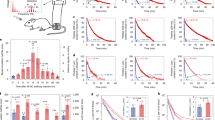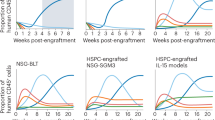Abstract
A tumour model system is reported that for many purposes may be an alternative to xenografted nude mice. The model allows immunotargeting of human tumour cells in immunocompetent animals. The target cells are contained in i.p. diffusion chambers (DC) with micropore membrane walls that are permeable to molecules, including the cell specific monoclonal antibodies (MoAb), but impermeable to cells. Thus, the tumour cells are protected from the host immunocompetent cells. In the work here presented the model was tested in immunocompetent mice and pigs, with tumour cells and antibody preparations that had demonstrated specific targeting in the nude mouse xenograft model. Hence, the DC were filled with cells from the human cell lines Hep-2 (expressing placental alkaline phosphatase, PLALP), or OHS (a sarcoma cell line), and the MoAb preparations injected i.v. were a 125I-labelled Fab fragment of the PLALP specific antibody H7, or a 125I-labelled F(ab')2 fragment of the sarcoma specific antibody TP-1. Specific targeting of the human tumour cells was demonstrated in both mice and pigs. The target: blood ratios were comparable in the two species, reaching a maximum of about 15 after 24 h with the Fab preparation, and a ratio of 25 after 72 h with the F(ab')2. The target uptake relative to injected dose was lower in pigs than in mice, but the difference between the two species was smaller than expected, presumably due to a slower antibody clearance in the pigs than in the mice. An artificial cell targeting system like this has several advantages in the search for solutions to many of the fundamental problems experienced in immunotargeting. Firstly, parallel binding experiments can be carried out in vitro with the same target. Because in vitro results are only influenced by the diffusion into the DC and the immunological binding characteristics of the antibodies, targeting differences between antibody preparations due to these factors can then be distinguished from differences due to pharmacokinetical properties. Secondly, the animals can be implanted with any type and number of target cells, or with antigen negative control cells. Thirdly, and perhaps most important, the system opens a possibility for evaluation of the murine MoAb in xenogenic species, and this may predict the clinical targeting potential better than experiments on mice.
This is a preview of subscription content, access via your institution
Access options
Subscribe to this journal
Receive 24 print issues and online access
$259.00 per year
only $10.79 per issue
Buy this article
- Purchase on Springer Link
- Instant access to full article PDF
Prices may be subject to local taxes which are calculated during checkout
Similar content being viewed by others
Author information
Authors and Affiliations
Rights and permissions
About this article
Cite this article
Fjeld, J., Bruland, Ø., Benestad, H. et al. Radioimmunotargeting of human tumour cells in immunocompetent animals. Br J Cancer 62, 573–578 (1990). https://doi.org/10.1038/bjc.1990.332
Issue Date:
DOI: https://doi.org/10.1038/bjc.1990.332



